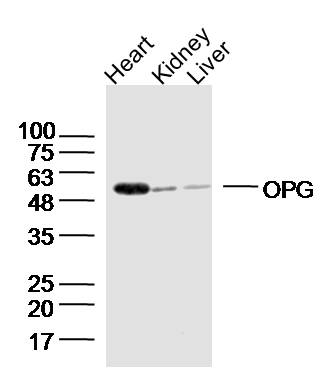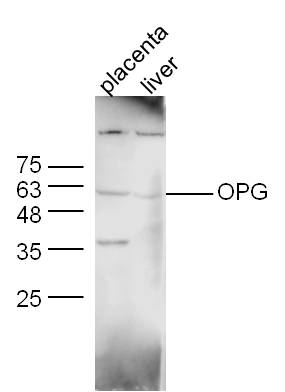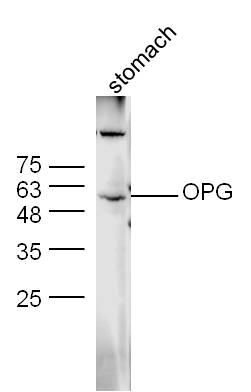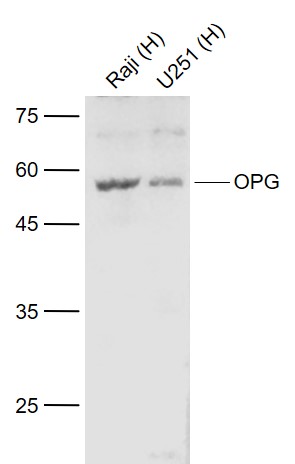
Rabbit Anti-OPG antibody
MGC29565; OCIF; OPG; Osteoclastogenesis Inhibitory Factor; TNFRSF 11B; TNFRSF11B; TR 1; TR1; Tumor Necrosis Factor Receptor Superfamily Member 11b; TR11B_HUMAN.
View History [Clear]
Details
Product Name OPG Chinese Name 骨保护蛋白/护骨素抗体 Alias MGC29565; OCIF; OPG; Osteoclastogenesis Inhibitory Factor; TNFRSF 11B; TNFRSF11B; TR 1; TR1; Tumor Necrosis Factor Receptor Superfamily Member 11b; TR11B_HUMAN. literatures Research Area Tumour Cell biology immunology Signal transduction marrow cells Immunogen Species Rabbit Clonality Polyclonal React Species Human, Mouse, Rat, (predicted: Dog, Cow, ) Applications WB=1:500-2000 ELISA=1:5000-10000 IHC-P=1:100-500 IHC-F=1:100-500 IF=1:100-500 (Paraffin sections need antigen repair)
not yet tested in other applications.
optimal dilutions/concentrations should be determined by the end user.Theoretical molecular weight 43kDa Cellular localization Secretory protein Form Liquid Concentration 1mg/ml immunogen KLH conjugated synthetic peptide derived from human OPG: 221-300/401 Lsotype IgG Purification affinity purified by Protein A Buffer Solution 0.01M TBS(pH7.4) with 1% BSA, 0.03% Proclin300 and 50% Glycerol. Storage Shipped at 4℃. Store at -20 °C for one year. Avoid repeated freeze/thaw cycles. Attention This product as supplied is intended for research use only, not for use in human, therapeutic or diagnostic applications. PubMed PubMed Product Detail Osteoprotegerin (OPG, or osteoclastogenesis inhibitory factor) is a secretory glycoprotein belonging to TNF receptor superfamily. Acts as decoy receptor for RANKL and thereby neutralizes its function in osteoclastogenesis. Inhibits the activation of osteoclasts and promotes osteoclast apoptosis. Bone homeostasis seems to depend on the local RANKL/OPG ratio. May also play a role in preventing arterial calcification. May act as decoy receptor for TRAIL and protect against apoptosis. TRAIL binding blocks the inhibition of osteoclastogenesis. OPG acts as a soluble factor in the regulation of bone mass and may be beneficial in the treatment of osteoporosis with increased osteoclast activity. OPG consists of 401 amino acids with a molecular weight of 44 kDa as a monomer and 90 kDa as a disulphide-linked dimer.
Function:
Acts as decoy receptor for RANKL and thereby neutralizes its function in osteoclastogenesis. Inhibits the activation of osteoclasts and promotes osteoclast apoptosis in vitro. Bone homeostasis seems to depend on the local RANKL/OPG ratio. May also play a role in preventing arterial calcification. May act as decoy receptor for TRAIL and protect against apoptosis. TRAIL binding blocks the inhibition of osteoclastogenesis.
Subunit:
Homodimer.
Subcellular Location:
Secreted.
Tissue Specificity:
Highly expressed in adult lung, heart, kidney, liver, spleen, thymus, prostate, ovary, small intestine, thyroid, lymph node, trachea, adrenal gland, testis, and bone marrow. Detected at very low levels in brain, placenta and skeletal muscle. Highly expressed in fetal kidney, liver and lung.
Post-translational modifications:
N-glycosylated. Contains sialic acid residues.
The N-terminus is blocked.
DISEASE:
Defects in TNFRSF11B are the cause of juvenile Paget disease (JPD) [MIM:239000]; also known as hyperostosis corticalis deformans juvenilis or hereditary hyperphosphatasia or chronic congenital idiopathic hyperphosphatasia. JPD is a rare autosomal recessive osteopathy that presents in infancy or early childhood. The disorder is characterized by rapidly remodeling woven bone, osteopenia, debilitating fractures, and deformities due to a markedly accelerated rate of bone remodeling throughout the skeleton. Approximately 40 cases of JPD have been reported worldwide. Unless it is treated with drugs that block osteoclast-mediated skeletal resorption, the disease can be fatal.
Similarity:
Contains 2 death domains.
Contains 4 TNFR-Cys repeats.
SWISS:
O08712
Gene ID:
4982
Database links:Entrez Gene: 4982 Human
Omim: 602643 Human
SwissProt: O00300 Human
Unigene: 81791 Human
护骨素又称护骨因子(osteorotegenin,OPG)、骨保护蛋白、破骨细胞生成抑制因子、骨保护素、破骨细胞抑制生成因子(osteoclastogenesis inhibitory factor,OCIF)
OPG属于TNF受体超家族,主要功能是抑制破骨细胞的分化、成熟破骨细胞的骨吸收活性,并诱导其凋亡。Product Picture
Heart (Mouse) Lysate at 40 ug
Kidney (Mouse) Lysate at 40 ug
Liver (Mouse) Lysate at 40 ug
Primary: Anti-OPG(SL0431R)at 1/300 dilution
Secondary: IRDye800CW Goat Anti-Rabbit IgG at 1/20000 dilution
Predicted band size: 43kD
Observed band size: 50kD
Sample:
Placenta (Mouse) Lysate at 40 ug
Liver (Mouse) Lysate at 40 ug
Primary: Anti-OPG (SL 0431R) at 1/300 dilution
Secondary: IRDye800CW Goat Anti-Rabbit IgG at 1/20000 dilution
Predicted band size: 43 kD
Observed band size: 60 kD
Sample:
Stomach (Mouse) Lysate at 40 ug
Primary: Anti-OPG (SL 0431R) at 1/300 dilution
Secondary: IRDye800CW Goat Anti-Rabbit IgG at 1/20000 dilution
Predicted band size: 43 kD
Observed band size: 60 kD
Sample:
Lane 1: Raji (Human) Cell Lysate at 30 ug
Lane 2: U251 (Human) Cell Lysate at 30 ug
Primary: Anti-OPG (SL0431R) at 1/1000 dilution
Secondary: IRDye800CW Goat Anti-Rabbit IgG at 1/20000 dilution
Predicted band size: 55 kD
Observed band size: 55 kD
Tissue/cell: rat tibia tissue; 4% Paraformaldehyde-fixed and paraffin-embedded;
Antigen retrieval: citrate buffer ( 0.01M, pH 6.0 ), Boiling bathing for 15min; Block endogenous peroxidase by 3% Hydrogen peroxide for 30min; Blocking buffer (normal goat serum,C-0005) at 37℃ for 20 min;
Incubation: Anti-Osteoprotegerin Polyclonal Antibody, Unconjugated(SL0431R) 1:200, overnight at 4°C, followed by conjugation to the secondary antibody(SP-0023) and DAB(C-0010) staining
Partial purchase records(bought amounts latest0)
No one bought this product
User Comment(Total0User Comment Num)
- No comment







 +86 571 56623320
+86 571 56623320




